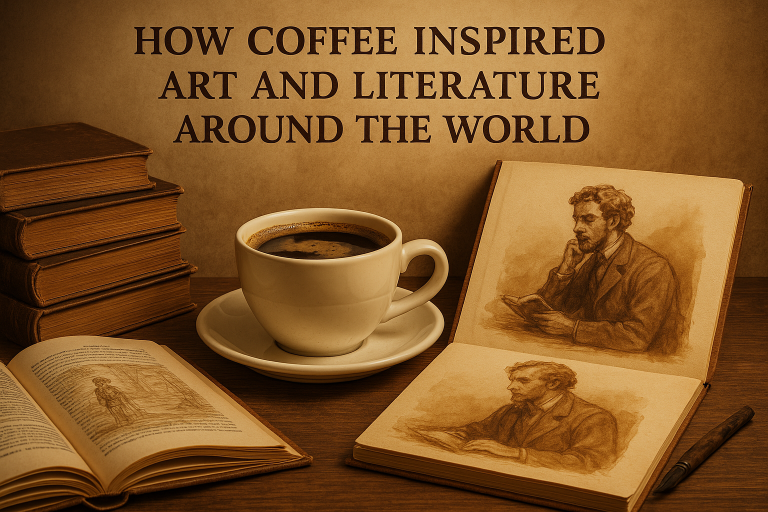
Coffee is more than just a beverage. It has fueled revolutions, sparked ideas, and ignited creativity for centuries.
Across the world, artists and writers have gathered in coffeehouses, drawn inspiration from the ritual of brewing, and poured their thoughts into canvases, poems, and novels — all while sipping from a humble cup.
In this article, we’ll explore how coffee shaped the art and literary movements of different cultures, revealing its deep influence on human expression.
The coffeehouse, since its rise in the 16th and 17th centuries, has served as an intellectual and artistic haven.
From Istanbul to Vienna, London to Paris, these spaces were more than places to drink — they were centers of thought, collaboration, and cultural rebellion.
Writers, painters, philosophers, and political radicals gathered over coffee to discuss ideas, critique each other’s work, and dream up new worlds.
The stimulating effects of caffeine, paired with an open atmosphere, created the perfect setting for artistic exchange.
In Ottoman Istanbul, qahveh khaneh were popular venues for storytelling, poetry readings, and debates. Patrons would sip strong Turkish coffee while engaging with wandering poets or performers.
In Paris, the 19th-century cafés of the Left Bank welcomed literary greats like Baudelaire, Verlaine, and later Hemingway and Joyce.
These spots were home to intense conversation, philosophical arguments, and the seeds of artistic movements like Impressionism and Existentialism.
Throughout history, coffee has played a subtle but persistent role in the evolution of literary culture.
During the Age of Enlightenment, European coffeehouses were referred to as “penny universities” — places where, for the price of a cup of coffee, anyone could participate in intellectual exchange.
Philosophers like Voltaire and Rousseau were regulars at Parisian cafés. Voltaire was famously said to have consumed 40 to 50 cups of coffee per day. He wrote and debated tirelessly, attributing much of his productivity to the beverage.
In England, figures like Samuel Johnson and Alexander Pope frequented coffeehouses like Button’s and Lloyd’s, where they engaged in literary banter and critiqued the day’s publications.
Romantic poets such as Lord Byron and Percy Bysshe Shelley were known to gather in cafés across Europe. Coffee helped fuel their late-night writing sessions, often accompanied by intense emotion, introspection, and radical political thought.
The early 20th century brought a new wave of writers to the coffeehouse scene.
In Paris, the “Lost Generation” — including Ernest Hemingway, F. Scott Fitzgerald, Gertrude Stein, and Ezra Pound — made cafés like Les Deux Magots and Café de Flore famous.
Hemingway, in particular, found coffee essential to his writing. In A Moveable Feast, he describes sitting in a Paris café with a notebook and espresso, watching people pass by as he crafted short, precise sentences.
These cafés became workshops for the modernist movement, encouraging experimentation, fragmentation, and a break from traditional literary forms.
Coffee has also appeared directly in literary works, often symbolizing comfort, routine, social bonding, or introspection.
In Marcel Proust’s In Search of Lost Time, coffee is paired with madeleines to unlock the narrator’s flood of memories — a now-iconic scene in literature. The sensory experience of drinking coffee becomes a metaphor for nostalgia and identity.
In Haruki Murakami’s novels, coffee is almost a recurring character. His protagonists often brew pour-over coffee in quiet, contemplative scenes. It serves as a meditative anchor amid surreal events and psychological complexity.
Even in thrillers or crime novels, a steaming cup of coffee can provide a moment of calm or contemplation — a ritual that grounds characters in an otherwise chaotic world.
The connection between coffee and visual art is equally compelling.
In 17th-century Europe, artists began to paint café scenes, reflecting the growing popularity of coffee culture. Dutch painter Adriaen van Ostade and French painter Nicolas Lancret captured the vibrancy of public coffee-drinking spaces.
In the 19th and early 20th centuries, artists like Édouard Manet, Edgar Degas, and Vincent van Gogh featured cafés and coffee drinkers in their works. Van Gogh’s The Night Café is a haunting depiction of loneliness within a bustling social space, rich in emotional intensity.
Later, Impressionists and Post-Impressionists used cafés as recurring settings. The interplay of light, shadow, and human expression found in café scenes allowed these painters to explore emotion, atmosphere, and the rhythms of everyday life.
Famous artists and writers often had strong relationships with coffee — not just socially, but as a part of their creative rituals.
Modern creatives still rely on coffee as part of their routines. Whether it’s a quiet morning ritual or a mid-afternoon shot of espresso, caffeine continues to serve as both muse and motivator.
In recent years, coffee has become a subject and even a medium for contemporary artists.
Some artists use coffee as paint, creating detailed portraits and landscapes using varying concentrations of brewed coffee. The earthy tones provide a unique aesthetic and connect the viewer to the sensory experience of the beverage.
Designers and illustrators also incorporate coffee themes into packaging, logos, and advertising. Specialty coffee shops now often collaborate with local artists to decorate walls, cups, and merchandise — turning cafés into mini art galleries.
There’s also a growing trend of performance art and installations that explore the global coffee trade, sustainability, and identity. These projects often aim to raise awareness about the people and cultures behind the coffee supply chain.
In the age of social media, coffee has become a visual icon. Instagram feeds, Pinterest boards, and YouTube channels are filled with flat lays of latte art, cozy café interiors, and minimalist pour-over setups.
This “coffee aesthetic” goes beyond photography. It influences fashion, home décor, and even music playlists. Lo-fi hip hop, often paired with visuals of animated characters sipping coffee while studying or drawing, has become a global phenomenon.
This trend reflects a romanticization of the creative process — where coffee, ambiance, and solitude become tools for self-expression.
One of coffee’s most powerful qualities is its ability to connect people across cultures, time periods, and artistic styles.
In Arabic culture, coffee is central to hospitality and storytelling. In Japan, it’s tied to quiet, focused preparation and aesthetics. In Italy, espresso is a quick but meaningful daily ritual. Each culture expresses something different through how it serves, drinks, and represents coffee.
These expressions often find their way into art and literature, creating a rich global archive of coffee-inspired creativity.
Around the world, coffee shops continue to support local creativity. Many cafés host:
The informal, welcoming nature of a coffee shop provides a low-pressure environment for artists and writers to experiment and share. In an increasingly digital world, these physical spaces still offer a sense of human connection and shared inspiration.
From handwritten manuscripts to digital art, coffee has remained a faithful companion to creators. Its stimulating properties, cultural symbolism, and warm familiarity make it an enduring part of the artistic journey.
The next time you take a sip of coffee while reading a book, sketching an idea, or journaling your thoughts, remember — you’re participating in a tradition that stretches back hundreds of years. A tradition that links you to some of the world’s most celebrated minds.
Because sometimes, all it takes to spark a masterpiece is a little bit of caffeine and a quiet moment with your thoughts.

Gabriel Rodrigues é especialista em finanças pessoais e escritor, com ampla experiência em economia, planejamento financeiro e gestão de recursos. Apaixonado por ajudar as pessoas a alcançarem sua saúde financeira, ele explora temas variados, desde investimentos até estratégias de poupança. Quando não está escrevendo, você pode encontrá-lo estudando novas tendências financeiras e oferecendo consultoria para quem busca melhorar sua relação com o dinheiro.